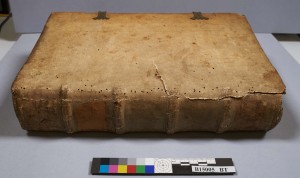Among the many treasures of the Burke Library, it is the Van Ess Collection that makes the book conservator’s heart beat fast. This collection of more than 500 volumes is unique in America for its high concentration of early European printed books in contemporary bindings. To the modern eye they are something out of a fairytale: hefty tomes with wooden boards covered in leather or alum-tawed skin, metal clasps holding the covers tightly sealed around massive paper text blocks that would make the largest phone book seem puny. Not bejeweled, with hardly a trace of gold leaf to be found, these bindings are treasures nonetheless. They were the workhorses of fifteenth- and sixteenth-century libraries and they remain in the same form, largely undisturbed, today, over 500 years later. (We should all age so well!)
An important history is preserved here, encoded in each binding’s structure and materials. Bookbinding in this period was done by hand, learned from a master and passed on to the next apprentice, and there were many practices that were highly regional, sometimes even particular to individual workshops. Structural features that are inconspicuous in the finished book, such as the manner of sewing or the attachment of the endsheets, or features that seem insignificant, such as whether the clasp’s catchplate is placed on the upper or lower cover, can actually provide crucial clues as to where and when the book was bound. This information is not found in any other aspect of the book. Binders of this period rarely signed their work and very few bindings are dated; furthermore, books were commonly sold as unbound sheets, so that the date and location of a book’s binding could be entirely independent of the date of printing.
Given the unique evidentiary value of bookbindings, their conservation poses some interesting challenges. How do we repair the volume that is prized for its unrepaired state? Future scholars will want to see the same features of the book that I want to see today. And yet these books are fragile–their structure may be intact but the materials have aged and cannot function like they used to. Many covers have become detached, or hang on to the text block by a single thread (literally). Wooden boards, weakened by insect damage and worn by centuries of use, have split. Covering materials are torn, spines are fragmentary, joints are splitting. If these books are to be consulted by scholars, some conservation intervention is required. It is my job to ensure that these magnificent bindings are preserved to tell their story to future scholars.
Recently I completed treatment of Alfonsi de Castro’s Ordinis Minorum Regularis Obseruantiæ almæ prouinciæ sancti Iacobi Aduersus omnes hæreses libri quatuordecim, printed in Cologne, Germany, in 1549.

The book’s wooden boards are covered with alum-tawed skin, which has become rigid with age, and is torn along the joints and on the front cover. Opening the book strained the covering material along these tears. Without conservation, these tears would likely grow. An intervention to stabilize the cover can prevent future damage.
 This photo taken during treatment shows the small pieces of Japanese tissue, a strong yet thin paper, that are used to bridge the two sides of the tear, preventing the tear from enlarging.
This photo taken during treatment shows the small pieces of Japanese tissue, a strong yet thin paper, that are used to bridge the two sides of the tear, preventing the tear from enlarging.
 The tissue “v-hinge” allows the covering material to move when the book is opened and closed, yet prevents the covering material from pulling away from the book any further and causing the tears to spread.
The tissue “v-hinge” allows the covering material to move when the book is opened and closed, yet prevents the covering material from pulling away from the book any further and causing the tears to spread.

After treatment the book does not look very different from before treatment, however the cover is stabilized. All treatment is carefully documented, so that scholars studying the bindings can recognize the materials I added. Additionally, conservation treatments are carried out using techniques that allow them to be removed later without damage to the original.